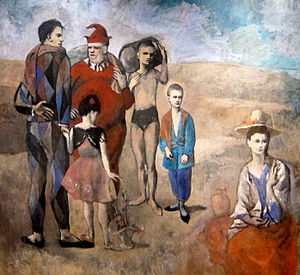Family of Saltimbanques
| Family of Saltimbanques | |
|---|---|
 |
|
| Artist | Pablo Picasso |
| Year | 1905 |
| Medium | Oil on canvas |
| Dimensions | 212.8 cm × 229.6 cm ( 83 3⁄4 in × 90 3⁄8 in) |
| Location | Chester Dale Collection, National Gallery of Art, Washington, D.C. |
Family of Saltimbanques (La famille de saltimbanques) is a 1905 painting by Pablo Picasso. The work depicts six , a kind of itinerant circus performer, in a desolate landscape.
It is considered the masterpiece of Picasso's Rose Period, sometimes called his circus period.
It was painted during a period from late 1904 to early 1906 when Picasso explored themes using the saltimbanque. Picasso frequently attended the Cirque Médrano in Montmartre.
The composition groups the saltimbanques together but they seem disconnected and do not look at one another.
Critics have suggested Family of Saltimbanques is a covert group portrait of Picasso and his circle, symbolized as poor, independent and isolated. The painting was removed from the Spanish salon at the IX Biennale of Venice in 1910, because considered inappropriate by the organization.
Bohemian–Austrian poet Rainer Maria Rilke (1875–1926) was inspired by this painting as he wrote the fifth of ten elegies in his Duino Elegies (1923). Rilke used the figures in Picasso's painting as a symbol of "human activity ... always travelling and with no fixed abode, they are even a shade more fleeting than the rest of us, whose fleetingness was lamented." Further, although Picasso's painting depicts the figures in a desolate desert landscape, Rilke described them as standing on a "threadbare carpet" to suggest "the ultimate loneliness and isolation of Man in this incomprehensible world, practicing their profession from childhood to death as playthings of an unknown will...before their 'pure too-little; had passed into 'empty too-much'."
A related work in gouache and pastel is Family of Acrobats (1905).
...
Wikipedia
